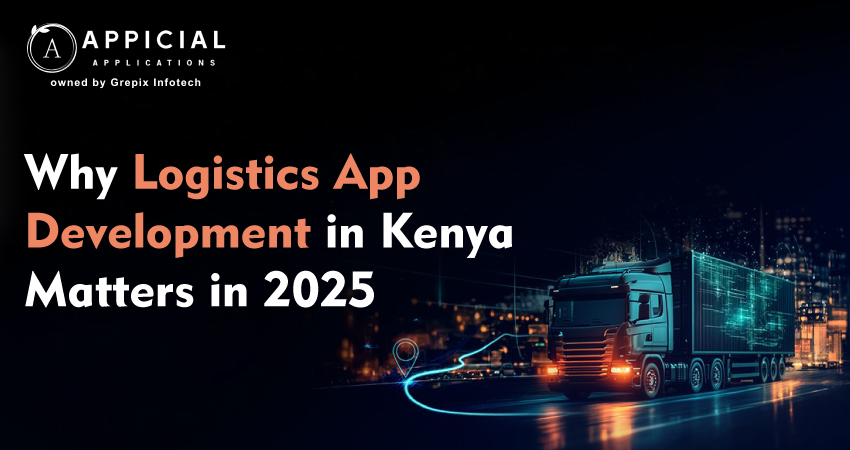
Why Logistics App Development in Kenya Matters in 2025
Consider a mother in Nakuru who is awaiting her child's medication. Before the lunch rush, a Nairobi café owner is pacing while she awaits fresh supplies. Uncertain of whether he will arrive in time, a rider is caught in traffic in Mombasa.
This is everyday life in Kenya.
People are moving goods across towns and cities every hour. But it’s not always smooth. Packages get delayed. Riders get lost. Businesses lose customers because of late deliveries.
This is why Kenya needs reliable delivery tracking apps now more than ever. For this reason, developing a logistics app in 2025 is not just a smart idea. It's a means of assisting companies in expanding, generating employment, and improving the lives of thousands.
We also unpack supply chain tech opportunities in Kenya’s B2B and B2C markets, from helping supermarkets restock on time to ensuring medical supplies reach hospitals when they are needed most. You will receive a clear and honest assessment of the logistics app development costs in Kenya, along with a practical timeline to plan your launch with confidence.
The blog highlights real regional examples like Sendy and Twiga Foods, showing how local businesses have successfully used last-mile delivery technology to create impact and growth.
Finally, we share how Appicial Applications can guide you in building a scalable, clean, and easy-to-use mobile logistics app tailored for Kenya’s unique challenges and opportunities. Your logistics app has the potential to revolutionize Kenyan transportation, whether your goal is to assist farmers, riders, or urban delivery services.
This guide will give you the precise actions you need to take if you're prepared to develop a logistics app that streamlines, expedites, and improves the delivery experience for Kenyan companies and consumers.
Businesses in Kenya move goods every hour, and the roads are congested. However, many continue to face difficulties with unclear routes, unreliable tracking, and delayed deliveries. This is why logistics app development in Kenya is not just timely in 2025, it’s necessary.This blog explains why investing in delivery tracking apps now will help businesses deliver faster while reducing fuel costs and improving customer trust. You will discover the essential features needed to build a logistics app that truly serves Kenyan customers, riders, and business owners. We discuss fleet management tools that help businesses keep vehicles in top shape, plan better routes, and reduce waste while ensuring riders work efficiently.
Why Build a Logistics App in Kenya
Kenyan businesses are growing. But delivery in Kenya is tough. Traffic can hold up deliveries for hours. Riders may not have clear delivery routes. Businesses can lose track of where their goods are.
A delivery tracking app changes this. It shows customers exactly where their package is. It gives businesses updates. It helps riders find the best routes.
Fleet management helps businesses cut fuel costs, prevent misuse, and manage their teams easily. It helps riders plan deliveries better.
With supply chain tech, businesses can manage stock levels and deliveries with fewer mistakes. They can move goods faster and cheaper.
Kenya’s young population is ready. People trust apps for payments and shopping. Now they need them for deliveries, too.
Essential Features of a Logistics App
Your logistics app should feel like a partner to your customers.
Here’s what it needs:
- Live Tracking: So customers know exactly where their package is using your delivery tracking app.
- Route Planning: To avoid traffic and save time.
- Easy Payments: Include M-Pesa, card, or cash to fit every user.
- Proof of Delivery: Riders can capture signatures or photos for clear records.
- Fleet Management Dashboard: Let businesses track riders, fuel use, and vehicle health.
- Real-Time Notifications: Let customers know when to expect their delivery.
- Reports and Insights: Help businesses see delivery times, rider performance, and fuel costs.
With these features, your app will solve real delivery challenges for real people in Kenya.
Opportunities in B2B and B2C Logistics
Kenya’s logistics market has big potential.
B2B logistics
Think of suppliers moving products to supermarkets, schools, and pharmacies. They need fleet management to avoid losses, plan deliveries, and keep track of goods.
B2C logistics
Online shops are booming. Customers want deliveries on the same day or within hours. They want updates and fast last-mile delivery.
Your app can support e-commerce shops, food suppliers, medical supply chains, and farmers. You will help them deliver faster, serve customers better, and grow their businesses.
Cost of Logistics App Development
Building a reliable delivery tracking app needs a clear plan and investment.
| App Type | Estimated Cost | Description |
|---|---|---|
| MVP | $15,000 - $22,000 | Basic version |
| Full-feature App | $28,000 - $45,000 | Advanced features and scalability |
| Maintenance | Around 15% yearly | — |
